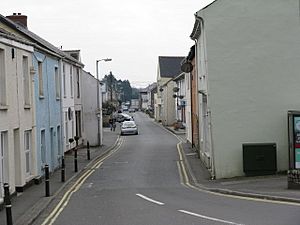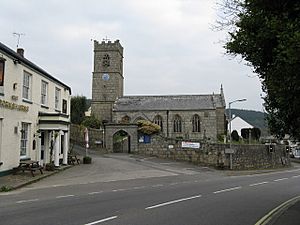St Blazey facts for kids
Quick facts for kids St Blazey
|
|
|---|---|
 Station Road, St. Blazey |
|
| Lua error in Module:Location_map at line 530: Unable to find the specified location map definition: "Module:Location map/data/Cornwall (mainland)" does not exist. | |
| Population | 4,674 (Civil Parish, 2011) |
| OS grid reference | SX069548 |
| Civil parish |
|
| Unitary authority | |
| Ceremonial county | |
| Region | |
| Country | England |
| Sovereign state | United Kingdom |
| Post town | PAR |
| Postcode district | PL24 |
| Dialling code | 01726 |
| Police | Devon and Cornwall |
| Fire | Cornwall |
| Ambulance | South Western |
| EU Parliament | South West England |
| UK Parliament |
|
St Blazey (Cornish: Lanndreth) is a small town in Cornwall, England, United Kingdom. It is located about 3 miles (5 km) east of St Austell.
The town is part of a larger area called a civil parish, which is also named St Blaise. This parish includes the village of Biscovey and other smaller areas like St Blazey Gate and West Par. In 2011, about 4,674 people lived here.
St Blazey was once a busy place for engineering, especially for mines and railways. Today, it is best known for being close to the famous Eden Project. The town gets its name from Saint Blaise, an Armenian saint. People in St Blazey celebrate his special day on February 3rd with a procession and service.
Contents
Discovering St Blazey's Past
The Story of Saint Blaise
The town of St Blazey is named after Saint Blaise. He is considered the town's patron saint. In Christian stories, Saint Blaise is believed to have helped people with toothaches, sore throats, and even sick animals.
Ancient History and Landmarks
A very old hillfort from the Iron Age is located about a mile northwest of St Blazey. It is called Prideaux Castle.
You can also find the Biscovey Stone nearby. This is part of an ancient Celtic cross. It once had writing on it, but you can't read it anymore. Some people think it's from around 600 AD, showing how the Saxons moved into the area. Others believe it's from about 900 AD. The top part of the cross was likely removed a long time ago. Today, the stone is at St Mary's Church in Biscovey.
The Church of St Blaise
The main church in St Blazey was built between 1440 and 1445. It is dedicated to Saint Blaise. Before this, there was an older church mentioned in records from 1294. The area was originally called Landrait or Landreath in Cornish, which means "Church on the Sand." A stone cross stands in the churchyard, but its history is a mystery.
Mining and Transport History
For many years, the area around St Blazey was important for mining. People mined copper and tin, and later, china clay. Mines like "The Par & St Blazey Consols" and "Par Consols Mine" were active here.
The River Par once flowed into an estuary below St Blazey. This meant St Blazey was the lowest place to cross the river. However, mining activities upstream caused the estuary to fill with silt. By the early 1800s, it had become marshland.
To help transport minerals, the Par Canal was built by Joseph Treffry between 1829 and 1835. This canal now forms part of the boundary with the nearby parish of Tywardreath and Par. The Par Harbour was also developed to ship these minerals.
The Par Canal was later replaced by the Cornwall Minerals Railway. St Blazey had a railway depot and station. While the depot is still used today, the passenger station closed in 1925. Now, people use Par station in the village of Par.
Changes in Parish Boundaries
In 1931, the parish of "St Balzey" had a population of 3,267 people. On April 1, 1934, this parish was joined with St Austell. Later, on April 1, 1983, a new civil parish called "St Blaise" was created.
Things to See and Do
The Eden Project
The famous Eden Project is located within the St Blaise civil parish. It's about 1.5 miles (2 km) from the center of St Blazey. Many visitors come to see its giant domes filled with plants from around the world. This has helped tourism grow in the town.
Nearby Attractions
Other interesting places are also close by. These include the Treffry Viaduct, a large old railway bridge, and the beautiful Luxulyan Valley. These spots are actually in the next parish, Luxulyan, but they are easy to reach from St Blazey.
Learning in St Blazey
Children in St Blazey attend primary schools like Biscovey Nursery and Infant Community School and Biscovey Junior School.
Sports and Recreation
Cornish Wrestling History
Cornish wrestling tournaments have been held in St Blazey for over 200 years. These events took place in different locations, including a field behind the Pack Horse Inn, the Foundry Meadow, and the St Blazey cricket ground.
Football Fun
The town has its own football team, St Blazey A.F.C.. A famous player, Nigel Martyn, who played as a goalkeeper for England, started his career at this club.
Cricket Club
St Blazey is also home to the St Blazey Cricket Club. They have two teams and play at their ground on Middleway Road. In 2019, the club won the Roseveare Cup. Both their first and second teams also moved up to higher divisions that year.
Famous People from St Blazey
Several notable people have connections to St Blazey:
- Edward Long, a historian, was born at Roselyon in 1734.
- Some people believe Ralph Allen, a famous architect known for his work in Bath, was born here.
- John Rogers, who helped bring the "man engine" (a machine to help miners) to Cornish mines, worked as a curate in St Blazey for a time.
- Charles Jeffries, a Commissioner in The Salvation Army, was stationed in the town in 1883.
See also
 In Spanish: St Blazey para niños
In Spanish: St Blazey para niños


